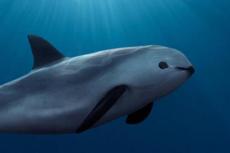As a cave diver, you do not come back from the Yucatán and say, “I have done Mexico,” boasting with pride and glory. It takes more than one visit to fully appreciate the enormous potential the peninsula has to offer underground. That means having not only the guts for it, but also the necessary training and experience to be able to do so. “Rome was not built in a day,” as the saying goes.
Contributed by
My first time in Yucatán was back in 1976, shortly after a devastating 7.5 magnitude earthquake had rocked Guatemala, just before the country intended to invade Belize over a historical border dispute. I was then a 21-year-old backpacker in blue jeans back then, hitchhiking my way across Latin America, from north to south. Learning Spanish was compulsory, and cave diving in Yucatán was virtually unknown in those days.
I came back to Yucatán in 2017. Frankly speaking, it was a bit of a shock. Tourism and incredible development had taken hold of the so-called “Riviera Maya.” I felt I had landed on the wrong planet. Playa del Carmen was just made for the Americans, the crazy rich and party lovers. It was obviously a place to be “seen,” show off and behave like a typical tourist, with straw hats and flower shirts, on an exotic beach holiday.
Mind you, I did not come for that. I would have run like a frightened rabbit, if not for a very noble goal: to become certified as a TDI Full Cave Sidemount Diver. I did the course with the superb, French-run dive operator Phocea Mexico. However, lest I forget, my initial cave diver training had been done in 2003 and 2007 in Mount Gambier, South Australia, with the reputable Cave Divers Association of Australia (CDAA)—the tough ones “down under.” I can still see my instructor Linda Claridge’s smile from here, after all these years. “You can die for that sort of mistake!” she said to me once, after a poorly executed exercise. Well, I guess it did some good, because I never forgot.
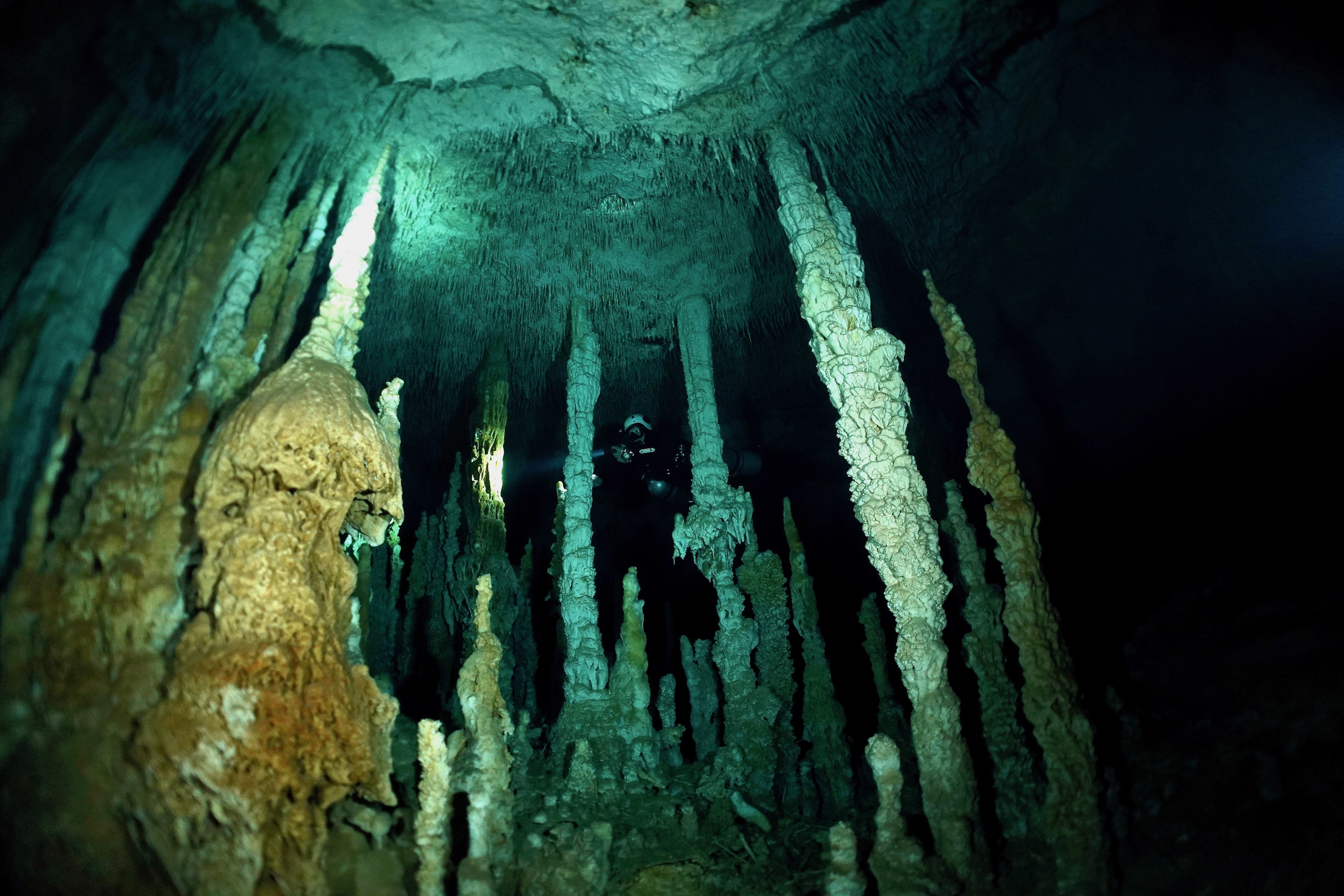
Cave diving in Yucatán
With the Full Cave Sidemount certification in my pocket, I was ready for the real thing. I dived a number of caves and cenotes on the eastern coast of Yucatán and produced some articles about it. The year after that (in 2018), I returned for more, focusing this time on the western side of Yucatán, around Mérida, where cenotes and caves are noticeably deeper, in the 40m zone. It was a conspicuous problem for me, in regard to decompression and compulsory gas mixes. I was not prepared for it.
Year 2019 saw me again in Yucatán, for a brief tour, driving around the peninsula, from Quintana Roo to Campeche and Mérida, to have a look at different archaeological and palaeontological sites as well as hidden, out-of-the-way cenotes. Some of the old forgotten ruins I visited were just awesome and impressive in their own right. Eventually, I came to believe that I had seen enough of the Yucatán. I did not imagine I would ever come back.
However, with more than 6,000 cenotes (and counting), that could not possibly and realistically be the end. Once infected with cave diving, I had additionally caught the virus of the Yucatán caves. Out of the blue, I decided to return in early September 2020, with some new training in mind—as if I needed a good excuse to fly back.

Getting there during a pandemic
There were no direct flights from Paris to Cancun, so I had to fly through Mexico with a “pain-in-the-neck” transit at 3 a.m., taking me to Cancun with Aeromexico at 10 a.m. Despite the coronavirus pandemic, Mexico had decided to keep its doors open for tourism. Even so, the state of Yucatán was closed, however, Quintana Roo was welcoming visitors.
Jonathan, my Full Cave instructor, was waiting for me. “You are my first student since the occurrence of Covid-19,” he confessed. A face mask was mandatory in shops, supermarkets and restaurants, but on the streets, nobody really cared. Few actually wore the cubre boca, as the mask was called here, although it was well advertised. However, the use of hydroalcoholic gel was widespread, which you could find anywhere, anytime. My three-day TDI Stage Cave Diver course was to start the next morning.
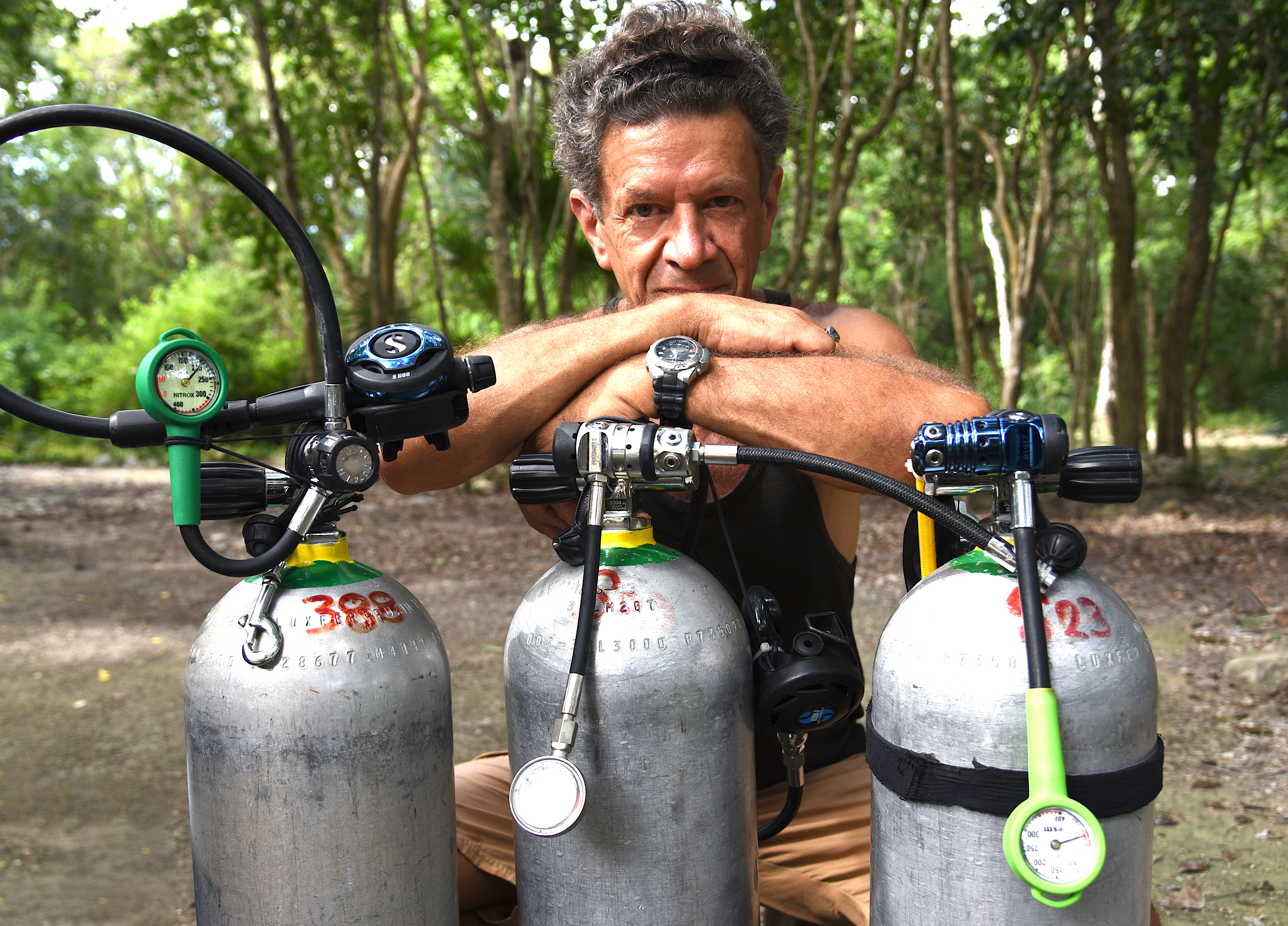
Stage training
Jonathan drove me to Cenote El Eden, located 25km south of Playa del Carmen, where the practical in-water training would be conducted. The place was deserted, except for the odd iguana that had been missing the tourists for a few months, and a furry brown mammal that zoomed past in a hurry.
As the name implies, the Stage course involves the use of a third tank, which is clipped on the left side of the body. The prerequisite for this level is Full Cave Sidemount certification. Jonathan first demonstrated the rigging of the third tank: a ring with a clip on the lower part of the tank, plus a clip with a bungee around the neck of the valve.
Once in the water, on the edge of a wooden platform, sidemount tanks would be donned first. With a movement of the left hand between the body and the side tank, one would then pull the bottom clip of the stage tank towards the back where it would be hooked to the D-ring at the left rear side of the harness. The top clip of the neck valve was to be attached to the front D-ring of the harness’s shoulder strap.
Ideally, the stage tank should lie below the sidemount tank, aligned with the body. The regulator hose of the stage is brought around the back of the head, and the regulator itself is taken into the mouth from the right. One is supposed to breathe from the stage tank first.
I was a bit apprehensive about looking like a Christmas tree, with so much to carry. Over time, I realised that the load of the stage tank created a growing tension on the lower right side of the back, as one needed to compensate to keep one’s balance in the water.

In-water session
Next, we submerged for a swim underwater around the cenote “to get the feeling.” Jonathan showed me how to unclip the stage, leave it on the bottom, and put it back on again. With a gesture of his hand, he invited me to do the same, without losing my buoyancy control! I had to repeat the exercise twice. Finally, I was required to unclip the lower part of the stage, and push the tank forward, as we passed through a “restriction” between the rocks. One hour passed in 25°C water; I felt fine in my 5mm shorty, but the picnic lunch afterwards was much appreciated!
We were back in the water once again, for afternoon training. Jonathan placed a line between two stumps of wood on the bottom, as the fish seemed to gaze in anticipation: “Are we going to play a game?” In the cave environment, we would get rid of the stage first, at some point during the penetration, and must therefore clip the tank onto the line, “preferably in the direction of the exit,” so we would know which way to go after retrieving the stage. It was easy to understand, but arguably not so straightforward to perform, because it was either hard to unclip the lower part or the upper part, if the bungee was too tight.
Adjustments are a very personal task. The other variable is the neutral buoyancy factor, which is affected by carrying or not carrying the stage, right? So, after I dropped the stage on the line, and closed the tank valve, Jonathan gestured to me in mime to continue along the line, as if going farther into the cave. In other words: Turn around, come back and retrieve the stage. The sudden change of weight made me crash into the sediment and grasses on the bottom. “Remember buoyancy control!” he said emphatically, upon debriefing.
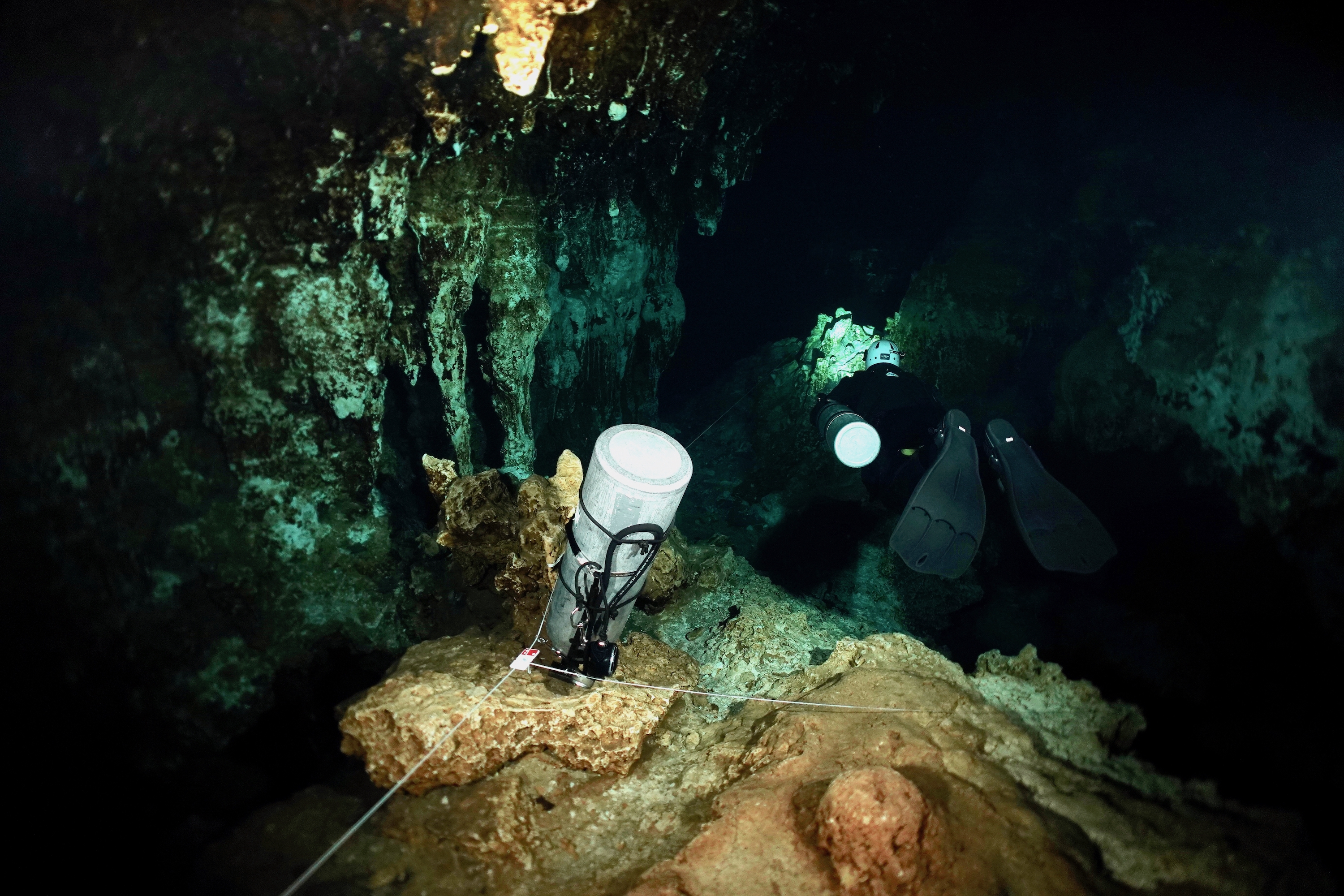
Repetition and challenges
The next morning, I had to do the exercise all over again. Visibility was good, there were only a few people around, the sun was shining, and my buoyancy was performed well. Jonathan gave me the OK signal.
It got more complicated when he wanted to simulate zero visibility conditions. For this exercise, he handed me a “black mask” underwater, which I had to put on my face. (Fortunately, he was not like my former instructor Linda, who had surreptitiously placed a black mask on my face from behind, without advance warning! Gosh.)
Anyway, with my eyes closed and a hand on the guide line, I progressed towards the stage clipped to the line, feeling it with one hand, then grabbing the lower clip and attaching it to my D-ring while still holding the guide line with my right. Then I grabbed the other clip and attached it to the D-ring on the shoulder strap—don’t forget your buoyancy, good man! I then opened the stage valve, swinging the regulator hose over my helmet, and switched regulators to breathe from the stage. I performed this manoeuvre without stress or hurry, and Jonathan gave me the thumbs-up, when I took off the black mask. Some miracles do happen!
That afternoon, we headed for a cave environment. We got into one of the cave tunnels with a halocline, which provided us with “exquisite” blurry vision, before we emerged into clear water. Jonathan signalled me to drop the stage on the guide line at 100 bars. We proceeded farther on sidemount, until we reached 130 bars. As we turned around, I took the lead, retrieving the stage and crashing a bit on the bottom. The whole dive lasted 76 minutes at a maximum depth of 15.4m. I did not get the thumbs-up for this one… Nobody’s perfect.
It rained heavily as we drove back to Playa del Carmen, and Jonathan criticised my swimming below the guide line at times. “People would judge you negatively for this,” he claimed. Back at the hotel, the room had not been made up yet, and the internet did not work… bummer. Should I call it Murphy’s Law? “Murphy was a cave diver,” argued one famous instructor in Tulum.
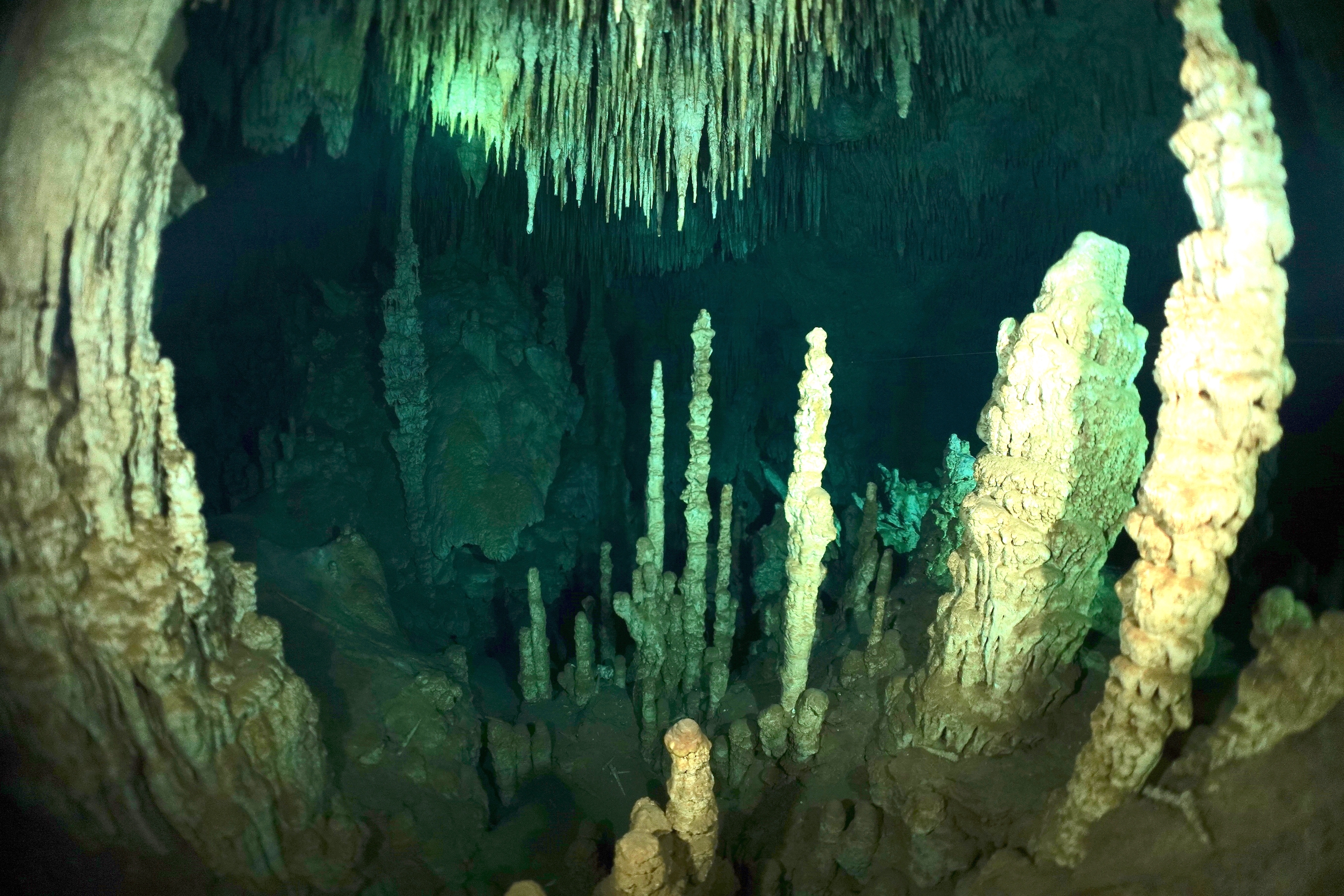
Cenote Otoch-Ha
On the third day, we drove to the end of a pot-holed dirt road in the Yucatán jungle, with pools of water. Cenote Otoch-Ha was part of the Sac Actun system, which had recently been discovered to be over 369km in length, connecting 227 cenotes!
The key to the main gate was obtained at a dive shop on the way, and I had to pay an entry fee of 200 Mexican pesos (US$10). Surrounded by trees and vines, the cenote looked dry and rocky at first glance, but there were water rings on the surface at the inner periphery, under the overhang. The place was full of mosquitoes. A large reddish-brown tarantula with black legs crawled by as we donned our equipment in silence.
Covered with leaves, an old cement stairway snaked down to a wooden platform overlooking the water. “Careful, it is not very reliable,” joked Jonathan. The water surface was pasted with a white film of calcareous sediments. The reflection of the crescent moon on the water rotated counterclockwise, as we ducked underwater, following the guide line.
At the first T-junction, we veered right, after leaving cookies on the line. At 36 minutes into the dive, with 100 bars left in the stage, I waved my dive light and the instructor signalled me to drop and clip the stage onto the line. Pushing farther into the cave on sidemount, we reached a second T-junction, where the water was very clear. The tunnel was wide, with stalactites, stalagmites, and sometimes straws hanging from the ceiling; pillars were everywhere. It was a beautiful cave. When I had 150 bars left in the side tanks, we were 55 minutes into the dive. Jonathan reckoned that we had covered 800m to 1,000m, with a maximum depth of 13.9m.
Leading the way back, I retrieved the stage, adding air to the wing in anticipation, and immediately rose like a balloon. A bit of a mess there, but I managed eventually. Back at the entrance for a safety stop, the stage was almost empty, and I had to switch to the sidemount tanks. The total dive time was 107 minutes—my longest cave dive ever. Jonathan was satisfied with my performance—a good thing indeed. Certification was granted. I had pushed my limits a bit. However, I realised that there was no way I would be able to dive while holding a camera mounted with arms and strobes, and carry a stage at the same time!
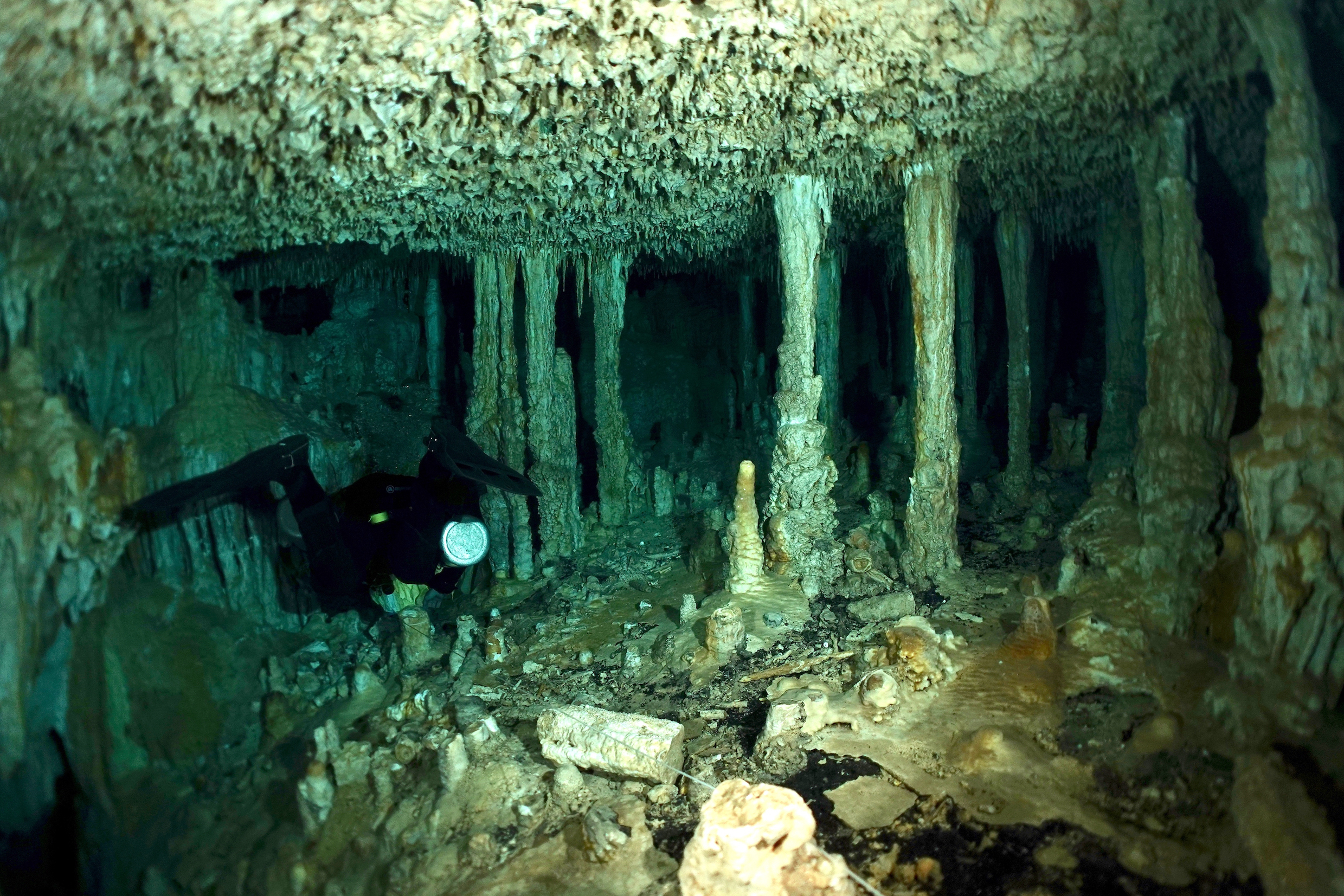
Cave photography
I remained an extra week in Playa del Carmen in order to do some more cave diving on sidemount, for the sole purpose of doing some underwater photography. Starting off with dive guide Attillio of Phocea Mexico, we dived Zacil-Ha and Carwash. Attillio had some fun taking me into the “Rabbit Hole,” a narrow, snaking tunnel, which was rather challenging with a camera. Not the coolest thing for claustrophobic people.
“How long is this going to last?” I wondered, until we emerged into a nice, fully decorated tunnel, and the very picturesque “Hall of Tears.” That was for starters. The main connection from Zacil-Ha to Carwash was black and dark—not very alluring. However, rising towards the lentil-shaped window of the Carwash cenote—with its psychedelic, apple-green colours and dead logs and branches emerging from the bottom—was a visual treat, for sure!

Cenote Cristal/Naharon
On Day Two, dive guide Thibault led me to Cenote Cristal/Naharon—a lush green oasis of exotic palms and trees, just west of Tulum. We were nearly the first to arrive at the site, if not for two bathers, taking a leisurely morning swim. Inside the cenote, a very dark black tunnel led us down to the halocline at 18m. We made two jumps to the left to reach a stunning chamber with stalactites, stalagmites and pillars.
Interestingly, this cave had been inhabited by prehistoric people. The skeleton of a 25- to 30-year-old woman, “The Eve of Naharon,” was discovered here in 2000, at a depth of 23m, and carbon-dated to 13,600 years ago. It has a similar skeletal type to that of the people of Southern Asia, rather than Northern Asia, and could be viewed at the Museo de la Prehistoria of Dos Ojos Park, on the way back to Playa del Carmen.

Dreamgate
Dreamgate was a semi-cenote in the jungle. Tanks were brought down on a rope to a wooden platform below the cliff. Seldom visited, with an entry fee of 380 pesos (~US$19), it was a bit of a hidden gem, which no one will want to show you, unless you are a decent and responsible cave diver with a serious regard for the overhead environment.
Rather shallow, with an average depth of 4 to 5m, Dreamgate was highly decorated throughout. It included a canyon in some parts, and a halocline was found here and there. Towards the end of the tunnel, after two jumps to the left, it got really narrow with restrictions. The maximum depth was 10m, for a total dive time of 70 minutes.
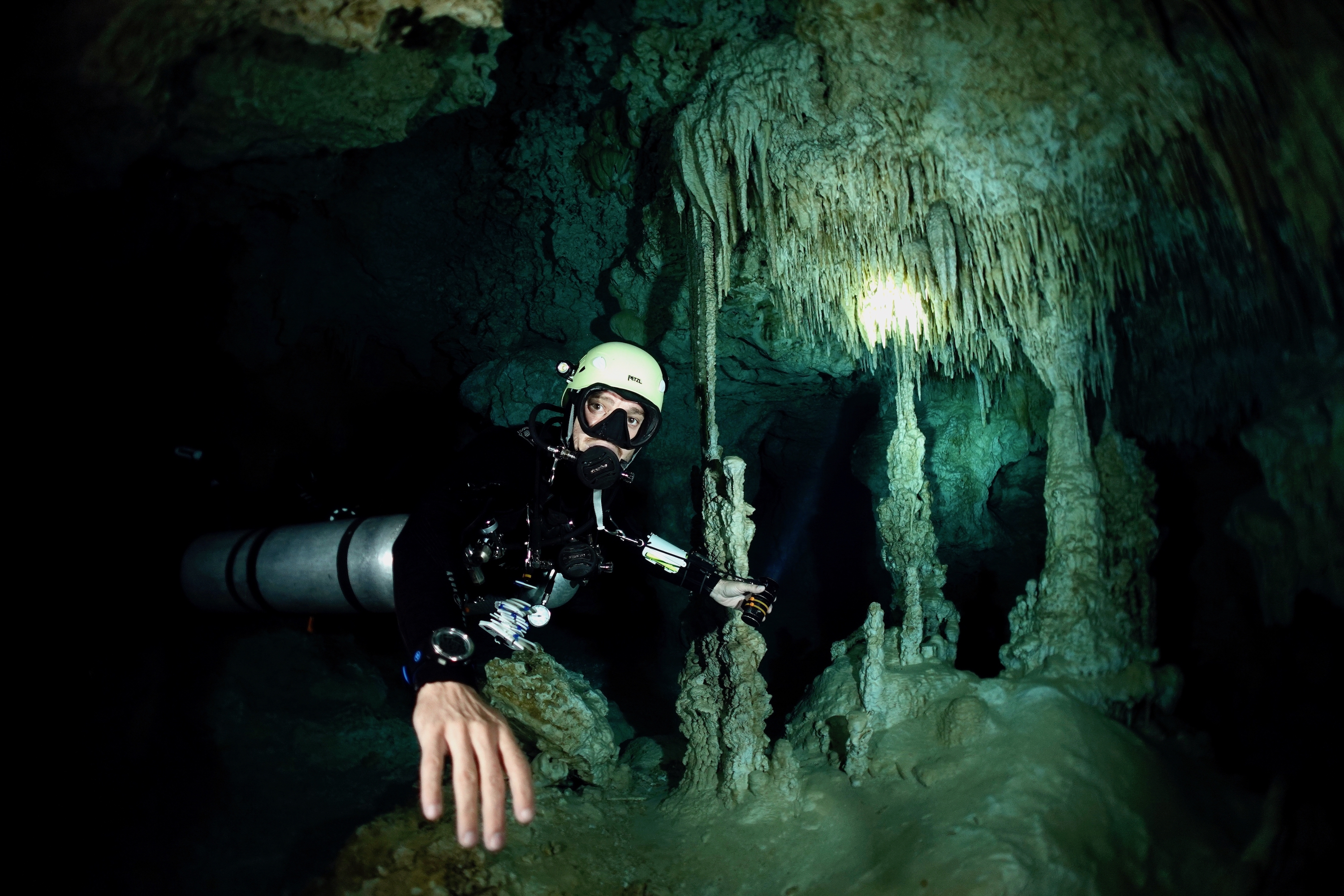
Cenote Chan Hol
On Day Three, we headed southwest of Tulum, on the road to Chetumal. Cenote Chan Hol (“Little Hole” in Mayan) is right next to the road on a farm with manicured gardens, separated from the highway by an old stone wall. The site was discovered and explored by Kim Davidsson in 2004.
A flight of stairs led to a small entrance, with poor to zero visibility underwater. Suddenly, you find yourself in an antechamber with a ledge on the right side, displaying two pieces of Mayan pottery and a few bones. The long winding corridor of the cenote had pillars, arches, helictites (a distorted form of stalactites) on the ceiling, as well as the usual stalactites. The cave floor was bedecked with deposits of white calcite flakes.
As I swam through the initially narrow, then widening passage, I imagined how Chan Hol had been a refuge for prehistoric peoples over 10,000 years ago, during the last ice age. Three Paleoamerican skeletons were discovered here from 2006 to 2009, and in 2016.
In 2009, a cave diver found human remains in Chan Hol II, some 1,240m southwest of the cave entrance, at a depth of 8.5m, then posted the photos on social media in February 2012. By the time the Mexican archaeologists came in late March, the site had been vandalised. The skull and bones were unscrupulously stolen, never to be found again.
Fragments of a hip bone embedded in a stalagmite, dated to 11,311 years ago (plus or minus 370), revealed after analysis that the fragments came from a young male. However, the skeleton was estimated to be from 13,000 years BP, one of the oldest ever found in Mesoamerica. An archaeologist from Dallas, Texas, claimed that there was convincing evidence that humans colonised the Americas over 14,000 years ago.

Cenote Dos Pisos
Dos Pisos was a small cenote on the El Campesino ranch and involved a short 80m walk through the jungle from the car park. The keyhole entrance was followed by a twisting passage to get to the main tunnel, which was highly scenic, with a succession of chambers and calcite flakes on the cave floor. The maximum depth was 6m, and the dive lasted 70 minutes. Rain caught up with us as we exited the place.
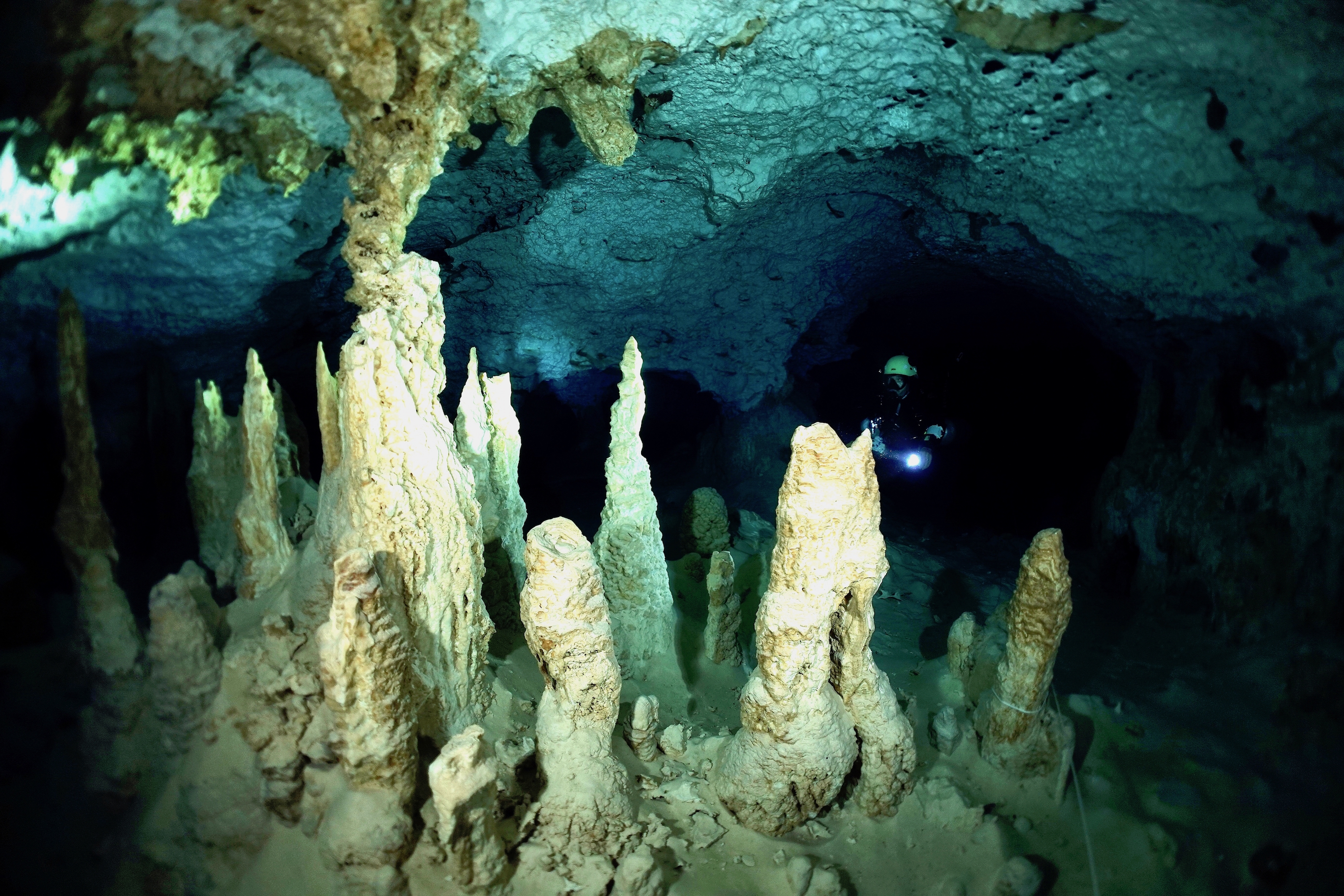
Cenote Calavera
Day Four saw us heading north, in the direction of Coba. On the right side of the road was the renowned Cenote Calavera (Skull). A hefty fee of 400 pesos (~US$20) is charged per cave diver, plus 200 pesos for the right to take photos! In addition, the guide must pay half price.
This semi-closed cenote is round, with a thick wooden ladder coming straight down into the water. One has to tie a piece of rope at the bottom of the stairs, in order to clip the tanks. Another line is fixed to the other side, to which a camera can be clipped.
This popular place attracted lots of people from all walks of life, posing for photographs at the edge of the hole. It was a bit of a distraction, but I regained composure when I hit the 26°C water.
The plan for today would be: T-right, T-left, T-right and a jump left. The halocline was met at 14m, in most of the winding tunnel, ending up in a canyon with crystal-clear water below the halocline. Madonna Passage was truly impressive, with a giant tooth-like stalagmite right in the middle of it. The maximum depth was 18.6m for a dive of 61 minutes.

Cenote Hatztun Aktun
Farther away, in the direction of Chetumal to the southwest, Hatztun Aktun was a wide-open cenote at the end of a dirt road. There was virtually no one around. A few convenient steps led to the central pool of water, which was green and dirty, with a high temperature of 29°C. As soon as we dived underground, the water temperature dropped to 25°C; we were feeling suddenly cool! With a dark, spongy and silty bottom, the water cleared up as we entered the large tunnel, which climbed up and descended down to a maximum depth of 21m.
The cave was full of thin pillars in clusters, with lots of helictites on the ceiling. We hit the halocline at 20m. Thibault wanted to proceed farther into the narrowing passage, but I had already reached my turning point. On the way back, he lured me with a jump to the right, indicating “for a little while” with his thumb and middle finger. Soon afterwards, he plummeted into a rabbit hole, zigzagging downhill, and I waved my dive lamp frantically before he disappeared around the corner! The rain came down on us, as we made it back to the pick-up point, just in time.
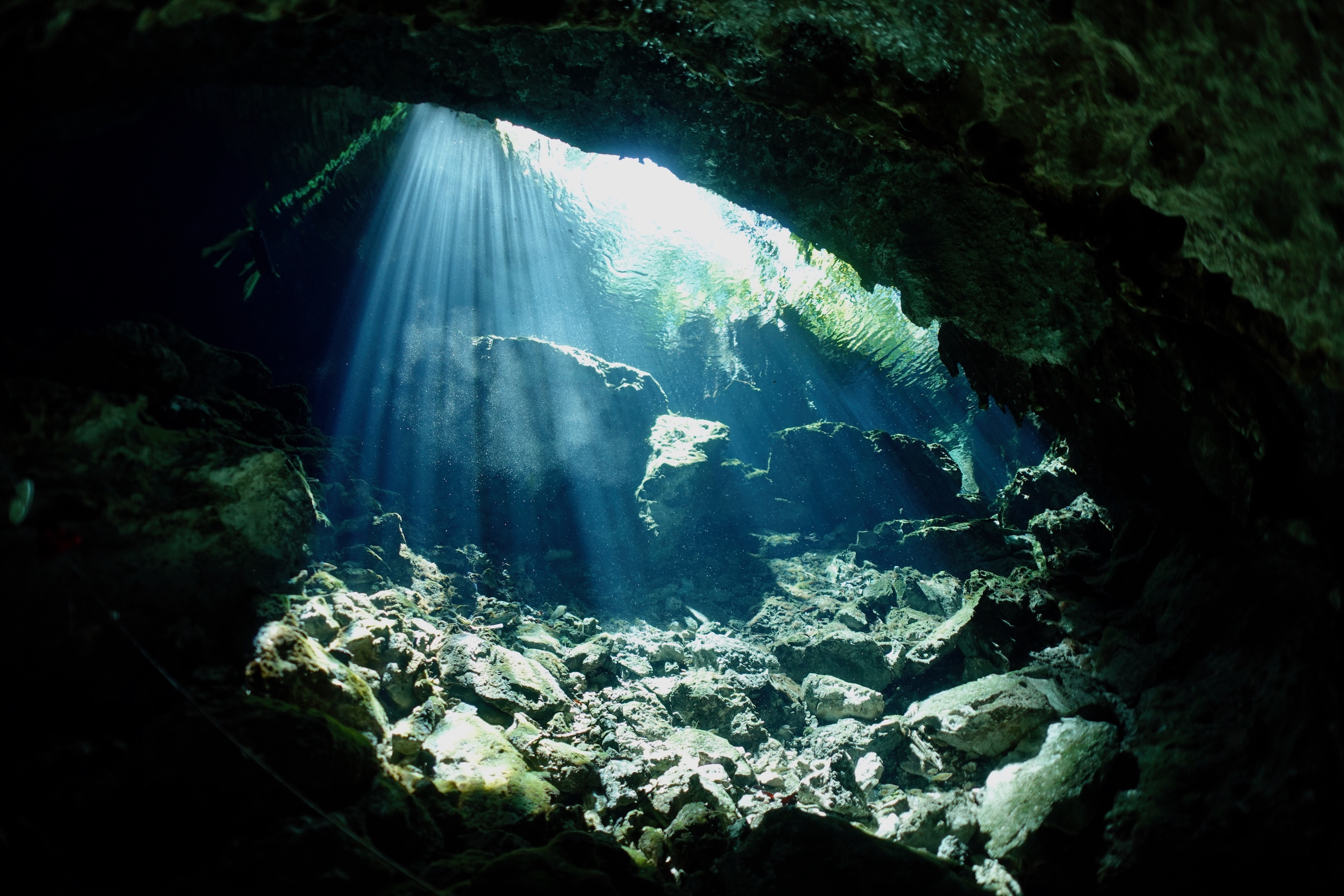
Cenote Minotauro
On my last day, the guide recommended Minotauro—a turquoise-blue pool of clear water with white sand and rocks, lying among the palms like a Japanese botanical garden. Idyllic. Diving the cenote, we squeezed through a narrow passage underwater for some time before it opened up into a larger tunnel with a bonanza of decorations. The speleothems, stalactites, stalagmites and pillars ranged from yellowish-brown to even a dark red, evidence of strong organic tannin colouration. Some stalactites displayed an elephant foot, with nothing underneath for support.
Strikingly, lots of big stalagmites and stalactites were tilted or lay broken on the cave floor—definite proof of an earthquake in the past. A whole block of stalactites had even collapsed from the roof—at least a couple of tons’ worth! This may be unusual; however, considering that the Caribbean Plate is in subduction under the Yucatán Peninsula, it was not surprising.
Referring to the Greek legend, the cenote’s name, “Minotauro,” stood for the fact that the cave was a real maze, with ramifications everywhere. Its maximum depth was 13.2m, for a dive of 67 minutes.
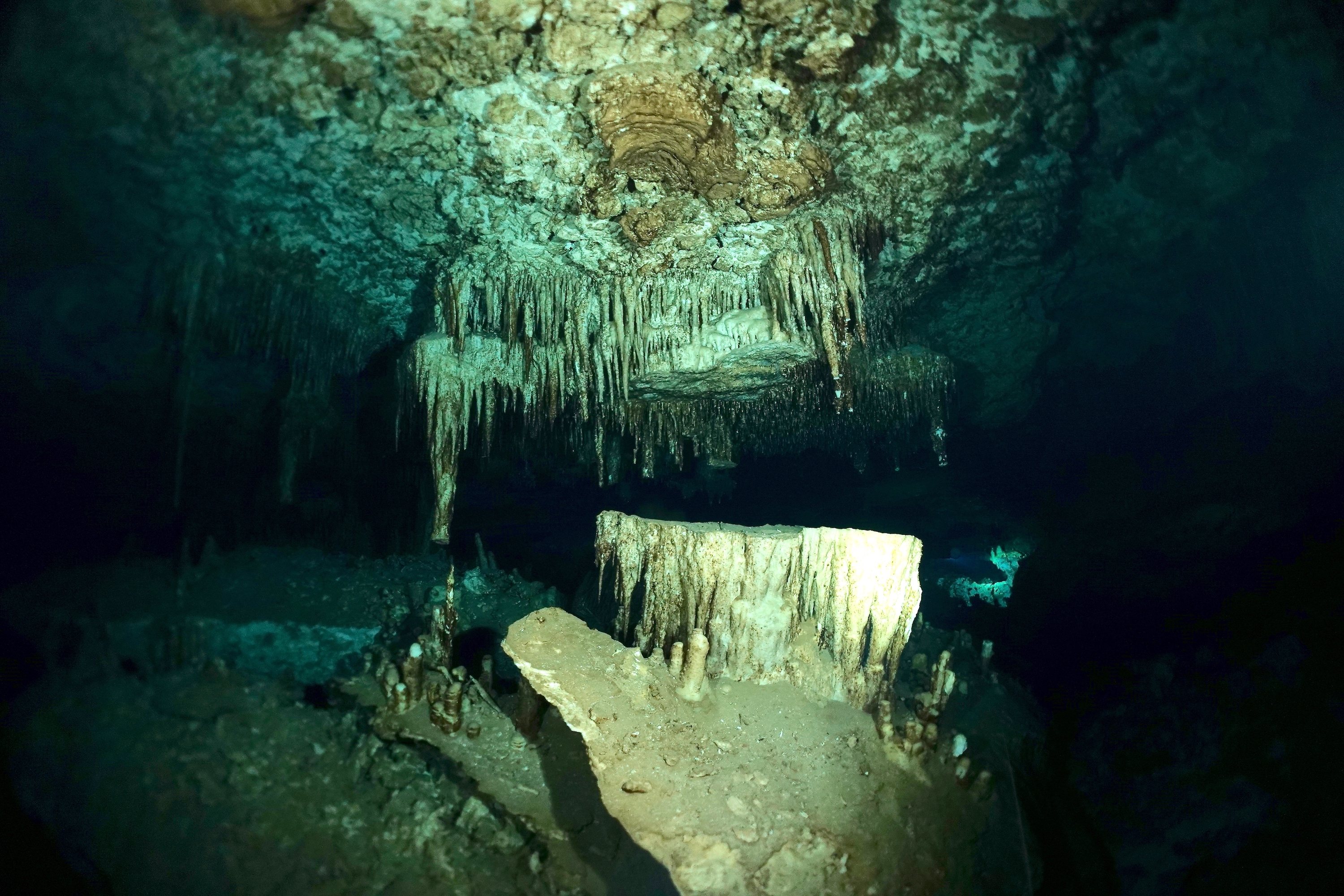
String of Pearls
The ultimate dive took place northeast of Playa, in the direction of Puerto Morelos. A cenote found in the forest, String of Pearls had an archway type of cave opening, with very shallow water for the first 30 metres or so. A curtain of fibrous roots hung down from the ceiling like “rasta” dreadlocks. Bats came in and out of the cave as we entered, knee-deep in water, lugging tanks farther in. There were swarms of mosquitoes for the bats to eat in the surrounding jungle!
As we penetrated a narrow passage, the cave floor suddenly dropped to 11m before rising up again. Unexpectedly, the camera battery died on me shortly after. I would now have to enjoy the scenery with my eyes only. The cave was very pretty. Lots of calcite crystals covered stalagmites and stalactites, as if budding like desert flowers, pinkish-white in colour. A jump to the left saw us swallowed by a narrow tunnel, where the halocline was present towards the end. It was a site I will remember with a pinch in my gut, since I was not able to capture any digital memories.
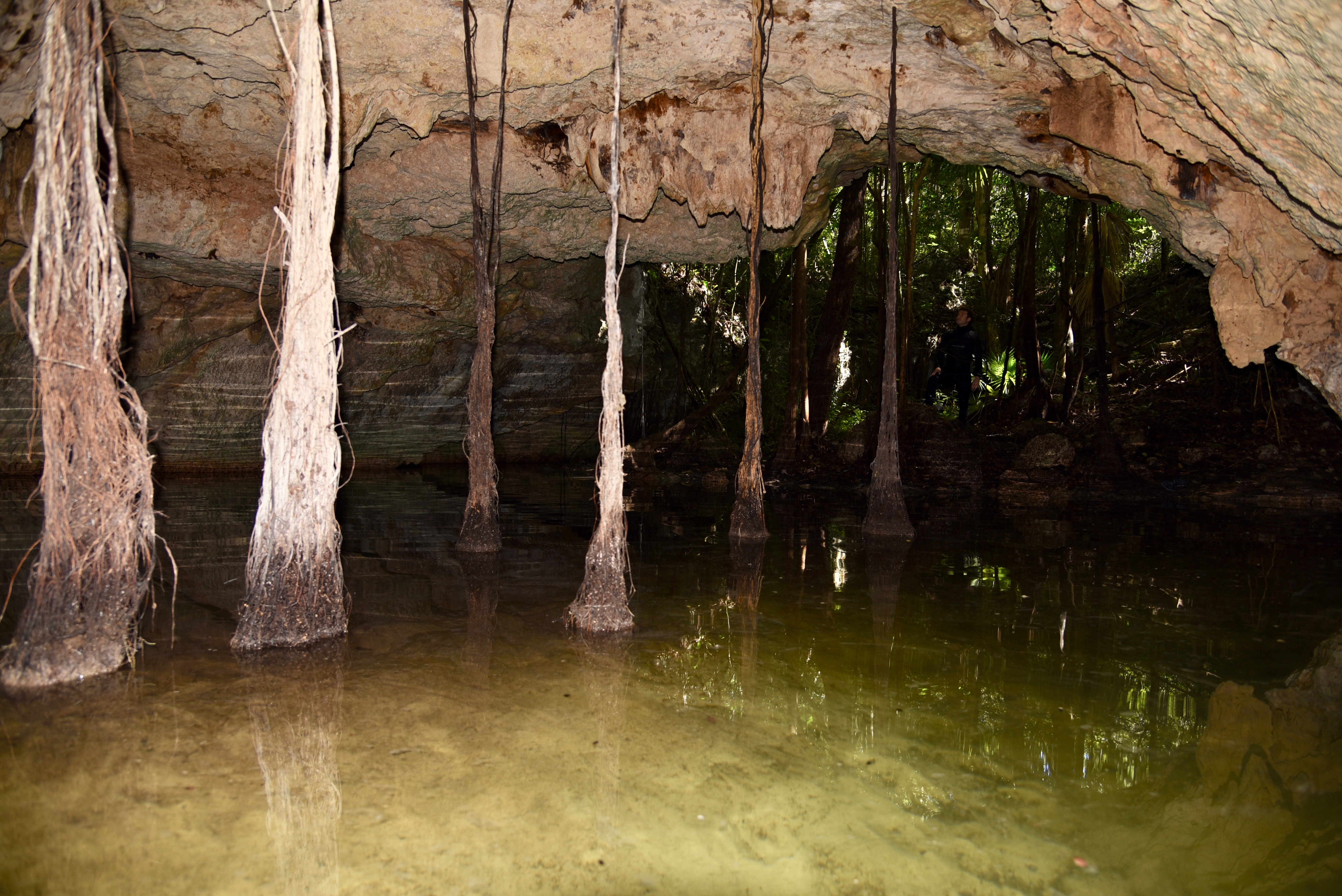
As we drove back to Playa del Carmen after a full day of diving, Thibault asked: “So, are you off to Paris tomorrow?”
“Not quite,” I replied. “I’ll take a day off, then I’ll go to Tulum.”
“A beach holiday or something?” he smiled, inquisitively.
“Hell, no!” I said. “I’m starting a DPV Cave Diving course in two days!” ■
Thanks go to Phocea Mexico (phocea-mexico.com) and ProTec Tulum (ProTecDiveCenters.com).
With a background in biology and geology, French author, cave diver, naturalist guide and tour operator Pierre Constant is a widely published photojournalist and underwater photographer. For more information, please visit: calaolifestyle.com.









